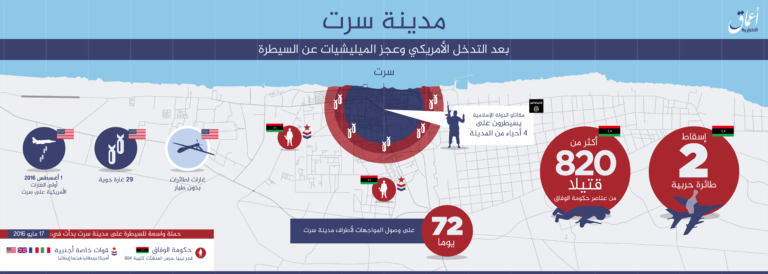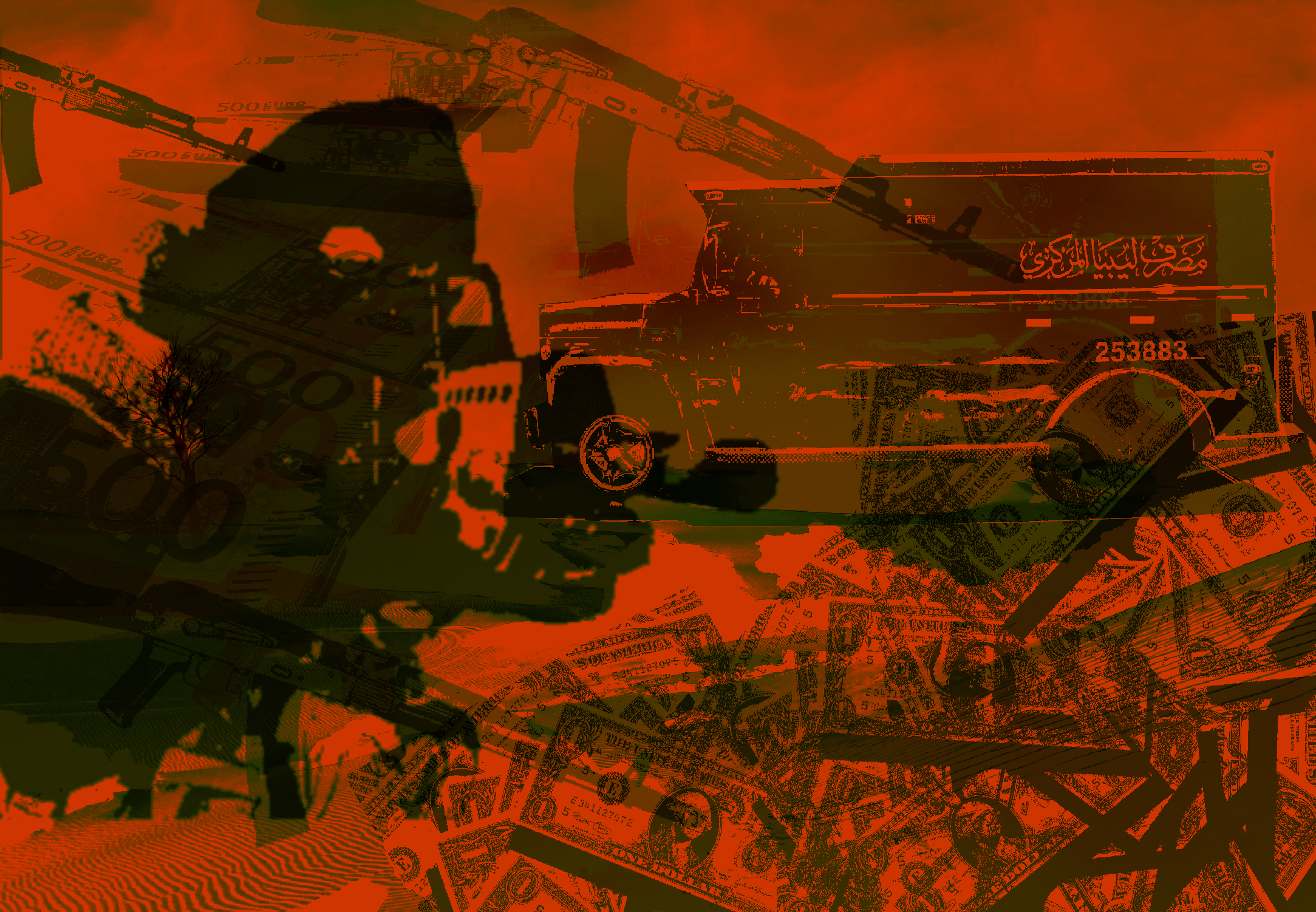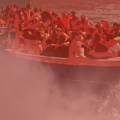Six years after protests first erupted in February 2011 against the brutal and repressive rule of Colonel Muammar al-Qadhafi, Libya remains a country beset by deepening political fragmentation, bloody internecine conflict and accelerating economic decline.
by Jason Pack – edited by Rhiannon Smith
The Islamic State (ISIS) capitalised on this instability and in late 2014 established a satellite branch in Libya, successfully seizing territory around the central coastal city of Sirte and expanding its influence across the country. By December 2016, an anti-ISIS military campaign supported by US airstrikes and led by militias aligned with Libya’s UN-backed Government of National Accord (GNA) – Libya’s internationally recognised government established under the December 2015 Skhirat Libyan Political Agreement – had succeeded in driving ISIS out of Sirte. However, the group is far from defeated and ISIS fighters are regrouping in the vast deserts and remote communities of southern Libya.1
Yet, while ISIS undoubtedly continues to pose a threat to security and stability in Libya, the group is neither the strongest nor the most dangerous jihadist2 group in Libya currently. Since those uprisings that culminated in Qadhafi’s violent death in October 2011, after 42 years in control, jihadist groups have grown in power and influence, often with funding from wealthy international backers. Although they remain largely on the fringes of Libyan politics and society, jihadists of all colours and stripes can influence developments in Libya due to the transitory and almost fickle nature of the country’s political and military alliances, as well as and the increasing polarisation and instability of institutions at the level of central government.
These jihadist networks also pose a threat to security outside Libya, as demonstrated by the horrifying suicide bombing against a Manchester arena on 22 May that killed 22 people and injured many more. The attack was claimed by ISIS and conducted by Salman Abedi, a British Libyan whose parents fled to the UK in the 1990s due to their connections to the al-Qaeda linked Libyan Islamic Fighting Group (LIFG).3 Abedi visited Tripoli shortly before he carried out the attack, and although at the time of writing it remains unclear whether Abedi received direct training or support for his attack from ISIS cells in Libya, or from associates closer to home, his familial connections to Libyan jihadist networks are significant.4 It is therefore crucial to understand who these Libyan jihadists are, how they interact with other actors, and what influence they can exert.
The Origins of Jihadism in Libya

Under Muammar Qadhafi’s authoritarian rule, political parties were banned, public engagement severely restricted and any opposition ruthlessly repressed. Photo: U.S. Navy photo by Mass Communication Specialist 2nd Class Jesse B. Awalt/Released
Under Qadhafi’s authoritarian rule, political parties were banned, public engagement was severely restricted and any opposition to the ‘brother leader’s’ highly personalised Jamahiriya (state of the masses) system of government was ruthlessly repressed. In this depoliticised environment, the mosque often provided the only space for alternative political socialisation, and Islamism became the best tool with which to engage in political activism and opposition.
While many of those resisting Qadhafi during the four decades before the 2011 uprisings espoused non-violent political Islamism, there were others who sought to oppose the regime through violent struggle, including using connections to global jihadist networks. Some Libyans travelled overseas to join jihadist groups, viewing jihad as a tool through which to transform local politics in Libya after their return. This trend was most pronounced in Benghazi and Derna as a result of Qadhafi’s systematic marginalisation of these eastern cities. The country’s east had been the seat of power of King Idris al-Sanussi, the first ruler of an independent Libya, whom Qadhafi overthrew in a bloodless coup when he seized power in 1969.
Libyans were amongst the so-called Afghan Arabs, volunteer fighters who travelled to Afghanistan in the 1980s to fight with the Afghan mujahideen, including al-Qaeda and the Taliban, against the Soviet army. Upon their return to Libya, these Libyan Afghan Arabs provided important connections to global extremist networks and constituted a driving force behind jihadist attempts to overthrow the Qadhafi regime from the 1990s onward. The Libyan Islamic Fighting Group (LIFG) was arguably the most influential of these Islamist opposition groups, and its ideological and operational legacy persists through inter-generational connections to jihadist networks within Libya and the Libyan diaspora. Libyans continued to join the ranks of jihadist groups overseas, as shown in records from 2006 and 2007 of a strong Libyan contingent among fighters who joined al-Qaeda in Iraq (AQI). AQI was the Iraqi Sunni al-Qaeda affiliate that was founded in 1999 by Abu Musab al-Zarqawi and later evolved into ISIS under the leadership of Abu Bakr al-Baghdadi.
Because none of the jihadists’ attempts to overthrow Qhadhafi’s regime succeeded, the leaders of Libya’s three key Islamist movements – the Muslim Brotherhood, the Salafists and the Libyan Islamic Fighting Group – agreed from 2006 onwards to abandon violent opposition to Qadhafi in return for their survival. As a result, Islamist political actors and jihadist militias were initially slow to participate in the 2011 uprisings against Qadhafi. However, when they did join in, they drew upon their global networks to acquire the funds, arms, and experience they needed to carve out their own fiefdoms in Libya’s chaos.
Jihadists in Benghazi: BRSC and Ansar al-Sharia

Benghazi Revolutionaries Shura Council logo.
 Two of the most well armed and well organised Islamist militias that formed in eastern Libya during the 2011 uprisings were the 17 February Martyrs’ Brigade and the Rafallah al-Sahati Brigade. After the fall of Qadhafi, these militias were integrated into the Ministry of Defence’s Libya Shield Force under the Libya Shield 1 unit led by Wissam Bin Hamid. However, Libya Shield 1 was dissolved in 2013 after it was involved in killing 32 anti-militia protestors in Benghazi; its constituent parts, along with members of Ansar al-Sharia, formed the jihadist Benghazi Revolutionaries Shura Council (BRSC).5
Two of the most well armed and well organised Islamist militias that formed in eastern Libya during the 2011 uprisings were the 17 February Martyrs’ Brigade and the Rafallah al-Sahati Brigade. After the fall of Qadhafi, these militias were integrated into the Ministry of Defence’s Libya Shield Force under the Libya Shield 1 unit led by Wissam Bin Hamid. However, Libya Shield 1 was dissolved in 2013 after it was involved in killing 32 anti-militia protestors in Benghazi; its constituent parts, along with members of Ansar al-Sharia, formed the jihadist Benghazi Revolutionaries Shura Council (BRSC).5
Ansar al-Sharia is a jihadist group which was formed in Benghazi by former revolutionary fighters in 2012 and now has branches in Libya, Tunisia and Egypt. The group has links with al-Qaeda and calls for the establishment of Shari’a (Islamic) law. Ansar al-Sharia fighters were implicated in the September 2012 attack on the US diplomatic mission in Benghazi which killed US Ambassador Chris Stevens and three others. Although the group advocated violence to achieve its aims, waging a campaign of assassinations, kidnappings and attacks against members of the former regime and their families in Benghazi, it also sought to increase its popular support through the provision of social services and charity and expanded into towns such as Derna, Ajdabiya and Sirte.6 Ansar al-Sharia became the largest jihadist organisation in Libya and strengthened its links to neighbouring Tunisia by running training camps for Tunisian and other foreign fighters and facilitating their transport to active jihad fronts including Syria and Iraq. The UN put Ansar al-Sharia on its al-Qaeda sanctions list in 2014, highlighting the group’s connections with al-Qaeda in the Islamic Maghreb (AQIM) and al-Mourabitoun (a splinter group from AQIM led by Mokhtar Belmokhtar), both North African jihadist groups with a presence in southern Libya.7.

Mohamed al-Zahawi. Still image from a video eulogy released by Ansar al-Sharia.
Ansar al-Sharia was significantly weakened following the death of the group’s leader, Mohamed al-Zahawi, in January 2015, and the defection to ISIS of many of the group’s members, including notable figures such as Ansar al-Sharia’s spiritual leader Abu Abdullah al-Libi.8 Furthermore, as ISIS expanded in Libya, tensions between the two jihadist groups grew as they competed for recruits, funding and territory. However, although Ansar al-Sharia and ISIS affiliates clashed in Derna and elsewhere, they have remained united in their fight against eastern strongman Field Marshall Khalifa Haftar and his anti-Islamist Operation Dignity campaign in Benghazi, which was launched in early 2014. Nevertheless, in recent months Haftar’s Libyan National Army (LNA) forces have gained the upper hand in Benghazi, retaking the Ganfuda neighbourhood from the BRSC and bombarding the last remaining jihadist enclaves in the centre of the city.9. Ansar al-Sharia’s declaration on 27 May 2017 that it had formally dissolved itself highlights the extent of the setbacks suffered by the group.10
Jihadists in Derna: DMSC and ISIS
During the 1980s and 1990s, many of the Libyan jihadists travelling to fight in Afghanistan and elsewhere overseas came from the small eastern city of Derna. Later the city renewed its distinction, supplying a new generation of Libyan jihadists to fight with al-Qaeda in Iraq in the 2000s and then with ISIS in Iraq and Syria. In 2012, fighters from Derna created the al-Battar Brigade, which eventually pledged allegiance to ISIS and fights to this day in both Iraq and Syria.11 As a city, Derna was marginalised under Qadhafi and remained politically isolated following the 2011 uprisings. The prominent role of Libyan jihadists in Derna meant that, by 2012, jihadist groups occupied the local governance and mediation roles that elected local councils played elsewhere in Libya. A lack of security prevented voting from taking place there during the 2012 and 2014 parliamentary elections or duringand the Constitution Drafting elections in 2014, while secular courts were suspended and gender segregation was enforced in schools, universities and offices.
 Throughout this period, various Islamist and jihadist groups battled between themselves for control of the city. Key players included al-Qaida-linked jihadist groups such as Abu Saleem Martyr’s Brigade (named after the infamous 1996 Abu Saleem prison massacre in which over one thousand mainly Islamist inmates are believed to have been killed by the Qadhafi regime) as well as an Ansar al-Sharia branch led by former Guantanamo Bay prisoner Sufian bin Qumu and the Islamic Youth Shura Council (IYSC), which in June 2014 formally pledged its allegiance to ISIS.12 In November 2014, Abu Bakr al-Baghdadi, the leader or ‘Emir’ of the Islamic State in Iraq and Syria, declared the establishment of an official Islamic State ‘province’ or wilaya in eastern Libya, centred on Derna. The IYSC and its ISIS-aligned allies then succeeded in consolidating control over strategic areas of the city and imposing ISIS’s strict and brutal social codes.13
Throughout this period, various Islamist and jihadist groups battled between themselves for control of the city. Key players included al-Qaida-linked jihadist groups such as Abu Saleem Martyr’s Brigade (named after the infamous 1996 Abu Saleem prison massacre in which over one thousand mainly Islamist inmates are believed to have been killed by the Qadhafi regime) as well as an Ansar al-Sharia branch led by former Guantanamo Bay prisoner Sufian bin Qumu and the Islamic Youth Shura Council (IYSC), which in June 2014 formally pledged its allegiance to ISIS.12 In November 2014, Abu Bakr al-Baghdadi, the leader or ‘Emir’ of the Islamic State in Iraq and Syria, declared the establishment of an official Islamic State ‘province’ or wilaya in eastern Libya, centred on Derna. The IYSC and its ISIS-aligned allies then succeeded in consolidating control over strategic areas of the city and imposing ISIS’s strict and brutal social codes.13
Many of Derna’s al-Qaeda-aligned jihadist groups refused to pledge allegiance to ISIS in part because it was a group imposed from outside Libya and in part because of ideological and strategic differences between ISIS and al-Qaeda affiliates in Libya. ISIS wanted to focus on top-down state-building and expanding its territory, while al-Qaeda was more concerned with resolving local socio-political grievances churned up by the 2011 uprisings. Although Derna’s powerful Islamist groups had already enforced strict interpretations of Shari’a law prior to the establishment of ISIS in the city, ISIS’s rule brought a new level of violence, cruelty and intolerance and resulted in practices which were alien to Libyan society such as the marriage of child brides to foreign fighters and the sanctioning of public executions, beheadings and even crucifixions.14
In December 2014, jihadist militias opposed to IYSC and ISIS joined together to form the Derna Mujahideen Shura Council (DMSC) coalition and sought to limit the groups’ growing power in the city. The DMSC also spearheaded efforts against Khalifa Haftar, whose Operation Dignity forces have been leading an offensive against Islamist groups in Benghazi and Derna since May 2014. Tensions between the DMSC and ISIS boiled over in June 2015 when ISIS killed Salim Derbi and Nasir Attiyah al-Akar, two top DMSC commanders. After this, the DMSC was able to harness widespread local anger against the group to evict ISIS from the centre of Derna, before completely driving ISIS affiliates from the outskirts of the city in April 2016. Since then, the DMSC was has been engaged in sporadic fighting with Haftar’s Libyan National Army (LNA) forces as the latter seek to drive all jihadist groups out of eastern Libya. Following the Manchester attack on 22 May and a subsequent ISIS attack against Coptic Christians in Egypt that killed at least 26 people, the Egyptian air force launched several airstrikes against DMSC positions, in coordination with the LNA. The DMSC is primarily focused on securing Derna from the LNA, and given ISIS no longer has a presence in Derna, it is likely that the airstrikes are an opportunistic attempt by Egypt to be seen ‘doing something’ while also supporting its ally Haftar.
Jihadists in western Libya: Belhadj, Ghariani and Tripoli’s Salafists
The Umar al-Mukhtar Brigade was one of the most organised Islamist brigades to fight against Qadhafi in western Libya in 2011 and comprised a core group of former Libyan Islamic Fighting Group (LIFG) members and other jihadists, as well as non-jihadist Libyans seeking more sophisticated military training. It was led by Abdul Hakim Belhadj, the former emir of the LIFG and a Libyan Afghan Arab who was tortured and imprisoned by Qadhafi for several years. Following the fall of Tripoli on 20 August 2011, Libya’s interim authority the National Transitional Council (NTC) appointed Belhadj to head the newly established Tripoli Military Council. With financial and political support from Qatar and backing from his close ally Ali al-Salabi, head of the radical faction of the Muslim brotherhood in Libya, Belhadj established the Islamist al-Watan political party.15 However the party failed to win any seats in Libya’s first elections in 2012, and though he remains influential Belhadj now focuses on furthering his many business interests in Libya.
Many other jihadist militias were also able to infiltrate Libya’s nascent post-Qadhafi state through the Supreme Security Committee (SSC) and the Libya Shield Forces (LSF), umbrella structures established to organise militia involvement in police and military functions respectively.16 The Interior Ministry’s SSC absorbed several Tripoli-based brigades that adhered to mainstream Saudi Salafism practices.17 The Tripoli branch of the SSC was led by powerful Salafi commander Hisham Bishr, with another Salafist, Abdurrauf Kara, commanding the Special Deterrent Forces (RADA) and Haitham al-Tajuri leading the Tripoli Revolutionaries’ Brigade.18 Although these forces formed a key component of the Libya Dawn (Fajr) coalition that evicted the elected parliament, the House of Representatives (HoR), from Tripoli in July 2014 and fought against Haftar’s Operation Dignity forces, they are now aligned with the UN-backed Government of National Accord (GNA) and constitute its main power base in the capital.

Sadiq Ghariani, here seen lecturing in Bayda, Libya. Photo: ليبي صح, WikiCommons, under CC BY SA 3.0-license.
An important rallying figure for many of Libya’s Islamists and jihadists is Sadeq al-Ghariani, who was appointed Libya’s Grand Mufti, the highest religious authority in the country, shortly after the 2011 uprisings. He is a controversial figure who has issued a series of extreme fatwas (religious edicts), including a call for the gender segregation of universities and workplaces.19 He is based in Tripoli and supported the Libya Dawn coalition against Haftar’s forces in the east. Al-Ghariani once implied that Haftar was a greater a threat to Libya than ISIS and argued against launching the anti-ISIS offensive in Sirte. Interestingly, there are longstanding tensions between al-Ghariani and many of the powerful Salafist brigades in Tripoli due to ideological and doctrinal differences in their religious practices.20
Al-Ghariani is also the symbolic figurehead of the hard-line Islamist political faction led by Khalifa al-Ghwell, the prime minister of the now-defunct National Salvation government, which is both against the UN-backed GNA in Tripoli and against Haftar and his Libyan National Army (LNA) forces in eastern Libya.21 Ghwell is from Misrata, Libya’s third largest city, which is located to the east of Tripoli and draws its power both from its position as the country’s commercial hub and from the central role played by its revolutionaries during the uprisings. Militias from Misrata were a key contingent of the Libya Dawn faction in 2014 and a number of the hard-line Islamist militias from the city now support Ghwell and his Islamist faction in Tripoli. However, Misratan militias also comprised the majority of the GNA-aligned al-Bunyan al-Marsus forces that fought against ISIS in Sirte, and many Misratan militias continue to support the GNA in Tripoli. In late May, following the Brak al-Shatti massacre and Manchester attack, there was a significant shift in power in favour of the GNA after pro-GNA militias managed to evict the hard-line, anti-GNA militias from key positions across the capital. However, further shifts in militia allegiances or the broader political power balanceAny shift in allegiances among pro-GNA militias in western Libya could easily lead to the collapse of the GNA and potentially strengthen various jihadist factions.
Jihadists in Central Libya: ISIS
 In late January 2015, shortly after al-Baghdadi recognised the ISIS wilaya in Derna, ISIS affiliates in Tripoli attacked a prominent hotel used by Libyan government officials and Westerners, killing 10 people. 22 A few days later, ISIS released a gruesome video showing 21 Christian Egyptians – who had been kidnapped in Libya – being beheaded on the shores of Sirte. These spectacular attacks marked ISIS’s zenith in Libya as the group increased recruitment and extended its territorial control. Many recruits came from neighbouring countries, and ISIS actually launched recruitment campaigns specifically aimed at foreign fighters, even establishing training camps for Tunisian fighters near Sabratha, a coastal city near the border with Tunisia. But Libyans constituted a significant number of the group’s rank and file.
In late January 2015, shortly after al-Baghdadi recognised the ISIS wilaya in Derna, ISIS affiliates in Tripoli attacked a prominent hotel used by Libyan government officials and Westerners, killing 10 people. 22 A few days later, ISIS released a gruesome video showing 21 Christian Egyptians – who had been kidnapped in Libya – being beheaded on the shores of Sirte. These spectacular attacks marked ISIS’s zenith in Libya as the group increased recruitment and extended its territorial control. Many recruits came from neighbouring countries, and ISIS actually launched recruitment campaigns specifically aimed at foreign fighters, even establishing training camps for Tunisian fighters near Sabratha, a coastal city near the border with Tunisia. But Libyans constituted a significant number of the group’s rank and file.
By mid 2015, ISIS had taken control of Sirte and established its headquarters there. Sirte is a coastal city in central Libya that was a stronghold of Qadhafi loyalists and had been largely abandoned by Libya’s central authorities since 2011. Powerful revolutionary militias from Misrata and Benghazi acted in effect as an occupying force in the city.23 This marginalisation created fertile ground for jihadist groups to put down roots, and as fighting intensified between the Libya Dawn and Dignity factions for control of the oil-rich Oil Crescent region to the south-east of Sirte, Ansar al-Sharia’s Sirte branch expanded its influence and social activities within the city, laying foundations upon which ISIS could build.
Although the powerful Misratan 166 brigade fought against ISIS in and around Sirte in the first half of 2015, ISIS proved resilient and for the next year Misrata focused on fighting Haftar’s forces instead. However, when two ISIS suicide bombings in May 2016 killed Misratan fighters in Abu Grein, a village situated roughly halfway between Misrata and Sirte, the direct threat posed by ISIS’s proximity to Misrata appears finally to have provoked Misratan militias to launch a concerted counter-offensive against ISIS. By this point the UN-brokered and internationally recognised Government of National Accord (GNA) had been established in Tripoli. It set up the al-Bunyan al-Marsus (steadfast wall) operations room to coordinate a military campaign to defeat ISIS in Sirte, although in reality the Misratan militias directed operations rather than the other way around.24

This map put out by ISIS itself in August 2016, acknowledged that its control had been limited to a few city blocks of Sirte by mid-August. In December, al-Bunyan al-Marsus forces declared that Sirte had been liberated.
The al-Bunyan al-Marsus (BM) forces made relatively swift gains against ISIS throughout summer 2016, pushing the group back to the outskirts of Sirte. However, ISIS was able to use guerrilla tactics, sophisticated booby traps and suicide attacks to prevent the forces ranged against it from achieving a swift victory. The GNA formally requested support, and on 1 August 2016 the US Africa Command launched Operation Odyssey Lightning, conducting 495 precision airstrikes against ISIS positions in and around Sirte by the time the operation officially concluded on 19 December 2016.25 BM forces declared Sirte liberated on 5 December, yet some military operations continued to the south of the city, where many ISIS fighters and commanders had fled during lulls in the fighting.
Despite ISIS being evicted from the city, Sirte’s future remains uncertain. Control of the oil-rich region around Sirte is highly contested by warring factions: the oil facilities and ports provide whoever controls them with valuable political leverage, especially at a time when the country’s economy is in dire straits. This central region marks the geographic and strategic ‘frontline’ between rival political factions in the west and east of the country. Since December 2016, the Benghazi Defence Brigades (BDB), a coalition of Islamist militias that aim to retake Benghazi from Haftar’s forces, has sought to take control of the Oil Crescent region from the LNA. After many failed attempts, in early March 2017 coalition succeeded in routing the LNA as far as Ajdabiya before the LNA drove the BDB back to its base in Jufra 11 days later.26 Shortly after, hostilities between Misratan-led, GNA-aligned militias and the LNA escalated in south-west Libya, culminating in GNA-aligned forces attacking the LNA-controlled Brak al-Shatti airbase on 18 May, killing as many as 140 LNA fighters.27 The backlash against this massacre led to a withdrawal of some Misratan forces from the area, however the situation remains volatile.
A zero-sum mentality favours jihadists
What Libya’s jihadist groups do, and how they interact with other factions, matters. The rise of jihadist groups and factions in Libya is both a cause and an effect of the lack of governance, instability and conflict which is currently plaguing the country. No single political or military faction has the power or resources to control the whole country, yet the zero-sum mentality that pits each faction against every other means that well-organised jihadist groups have as much chance as any other group of exerting power over specific cities or regions, as ISIS demonstrated in 2015. Although some mechanisms for negotiating a political solution to the crisis are in place, the recent escalation of conflict between rival factions in central Libya threatens to push the country into full blown civil war, a scenario that would play to the strengths of the currently weakened but resilient jihadist groups. Libya’s jihadists do not constitute a discreet entity in terms of ideology, organisational structure, allegiances or location, so they can never be completely defeated in a military sense. The key to reducing the power and influence of these factions is to address the marginalisation, insecurity and normalisation of violence that have facilitated jihadist recruitment and given a sheen of legitimacy to their brutal tactics.
Footnotes:
- “ISIS in Action”, Eye on ISIS in Libya, 10 January 2016, http://eyeonisisinlibya.com/isis-in-action/isis-fighter-says-tunisian-journalists-killed-in-derna/ ↩
- For the purposes of this article, Islamism refers to any form of social or political activism advocating that public and political life should be guided by Islamic principles, including calling for the implementation of Islamic law. Islamists can be violent or non-violent. In this article, jihadism or jihadist will be used to refer to Islamists who advocate the use of violent struggle to implement their interpretation of Islamic practices. ↩
- Alia Brahimi, “Why Libya is still a global terror threat,” The Guardian, May 25, 2017, https://www.theguardian.com/commentisfree/2017/may/25/libya-global-terror-threat-manchester-attack-gaddafi ↩
- Jason Pack, “20th-century Libyan jihadism’s role in Manchester attack,” Al Monitor, May 28, 2017, http://www.al-monitor.com/pulse/originals/2017/05/libya-jihad-manchester-attack-isis-salman-abedi.html#ixzz4iSgZfKik ↩
- “Libya: No Impunity for ‘Black Saturday’ Benghazi Deaths”, Human Rights Watch, 13 June 2013, https://www.hrw.org/news/2013/06/13/libya-no-impunity-black-saturday-benghazi-deaths ↩
- Mohamed Eljarh, “Benghazi’s Epidemic of Assassinations”, Foreign Policy, 30 October 2013 http://foreignpolicy.com/2013/10/30/benghazis-epidemic-of-assassinations/ ↩
- Mattia Toaldo and Mary Fitzgerald, “A quick guide to Libya’s main players”, ECFR, December 2016, http://www.ecfr.eu/mena/mapping_libya_conflict# ↩
- Thomas Joscelyn, “Ansar al Sharia Libya fights on under new leader”, Long War Journal, 30 June 2015, http://www.longwarjournal.org/archives/2015/06/ansar-al-sharia-libya-fights-on-under-new-leader.php ↩
- “Other Jihadi Actors”, Eye on ISIS in Libya, 21 March 2017, http://eyeonisisinlibya.com/other-jihadi-actors/15-21-mar-lna-liberates-ganfuda-retakes-oil-crescent-and-attacks-south/ ↩
- “Other Jihadi Actors”, Eye on ISIS in Libya, 30 May 2017, http://eyeonisisinlibya.com/other-jihadi-actors/24-30-may-ansar-al-sharia-officially-disbands/ ↩
- Ibid; Charles Lister, The Syrian Jihad: Al-Qaeda, the Islamic State and the Evolution of an Insurgency, (London: Hurst, 2015) ↩
- “ISIS in Action,” EOIL, 3 November 2014 http://eyeonisisinlibya.com/isis-in-action/action-3-november-2014/ ↩
- Maggie Michael, “How a Libyan city joined the Islamic State group,” Associated Press, 9 November 2014 http://bigstory.ap.org/article/195a7ffb0090444785eb814a5bda28c7/how-libyan-city-joined-islamic-state-group ↩
- Rhiannon Smith, “A House Divided: Jihadis Battle for Derna”, Tony Blair Faith Foundation, 10 July 2015 http://tonyblairfaithfoundation.org/religion-geopolitics/commentaries/opinion/house-divided-jihadis-battle-derna ↩
- “Profile: Libyan rebel commander Abdel Hakim Belhadj”, BBC, 4 July 2012, http://www.bbc.co.uk/news/world-africa-14786753 ↩
- Jason Pack, Karim Mezran, and Mohamed Eljarh, “Libya’s Faustian Bargains: Ending the Appeasement Cycle”, Atlantic Council, 5 May 2014, www.atlanticcouncil.org/images/publications/Libyas_Faustian_Bargains.pdf ↩
- Libyans have traditionally adhered to conservative Sunni interpretations of Islam, eschewing the more extreme Salafist interpretations of Islam often adhered to countries such as Saudi Arabia, and which advocate a return to the traditions of the Salaf (devout ancestors). ↩
- Lucy Provan and Rhiannon Smith, “Islamists tasked with drugs crackdown in Tripoli”, New Statesman, 7 February 2013 http://www.newstatesman.com/world-affairs/2013/02/islamists-tasked-drugs-crackdown-tripoli ↩
- “A comment too far?” The Economist, 3 September 2014, http://www.economist.com/blogs/pomegranate/2014/09/libyas-mufti ↩
- Mattia Toaldo and Mary Fitzgerald, “A quick guide to Libya’s main players”, ECFR, December 2016, http://www.ecfr.eu/mena/mapping_libya_conflict# ↩
- “Anti-ISIS Coalition”, Eye on ISIS in Libya, 18 October 2016, http://eyeonisisinlibya.com/the-anti-isis-coalition/anti-18-oct-16/ ↩
- Chris Stephen, “Ten Killed as Gunmen Storm Luxury Hotel in Libyan Capital”, The Guardian, 27 January 2015, https://www.theguardian.com/world/2015/jan/27/libya-gunmen-kill-guards-take-hostages-luxuy-hotel-tripoli ↩
- “ISIS in Action”, Eye on ISIS in Libya, 25 May 2015, http://eyeonisisinlibya.com/isis-in-action/action-25-may-2015/ ↩
- Alia Brahimi and Jason Pack, “Tactical lessons from the eviction of ISIS from Sirte,” Atlantic Council, 23 May 2017, http://www.atlanticcouncil.org/blogs/menasource/tactical-lessons-from-the-ejection-of-isis-from-sirte?utm_content=buffer5b874&utm_medium=social&utm_source=twitter.com&utm_campaign=buffer ↩
- “AFRICOM Concludes Operation Odyssey Lightening”, AFRICOM, 22 December 2016, http://www.africom.mil/media-room/pressrelease/28564/africom-concludes-operation-odyssey-lightning ↩
- “Other Jihadi Actors”, Eye on ISIS in Libya, 7 March 2017, http://eyeonisisinlibya.com/other-jihadi-actors/islamist-benghazi-defence-brigades-seize-oil-crescent-ports/ ↩
- “Anti-ISIS Coalition”, Eye on ISIS in Libya, 23 May 2017, http://eyeonisisinlibya.com/the-anti-isis-coalition/17-27-may-gna-aligned-forces-attack-brak-al-shatti/ ↩


 Print Friendly
Print Friendly







[…] a long form article for Norwegian NGO Hate Speech International, Jason Pack and Rhiannon Smith map out the history and context of Libya’s myriad jihadist […]